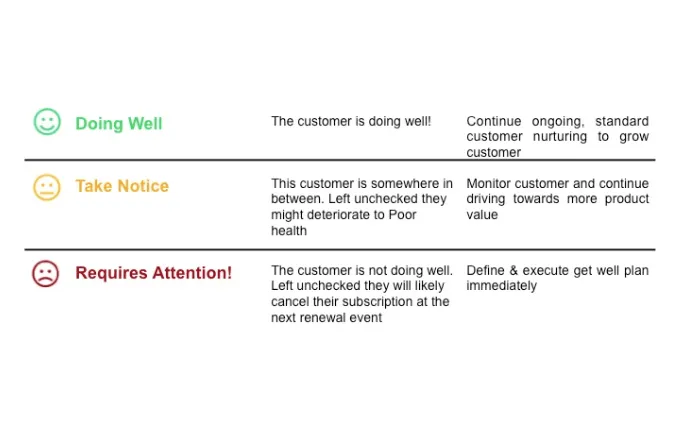A – Z Customer Success Terms

If you have worked in a tech company in the last ten years, you’ve most likely heard of some buzzwords that have come and gone as quickly as shooting stars – initially with great excitement and hope, only to slowly lose their power and fade away.
Big data, disruption, innovation, smart – everything, agile, blockchain, cloud – these are all ideas that were hyped to the max and now seem to carry a little less weight than they used to.
But unlike these buzzwords, there is one concept that has made its way into SaaS and is here to stay.
I’m talking about the idea of customer success, of course. But why has this concept stuck around when others haven’t? What truly defines customer success? And how does it stand out from other SaaS-related terms?

Table of Contents
Customer Success, the Legend and the Legacy
You may be familiar with the story about the birth of customer success. If not, I’ll give you a quick overview: Customer success began its journey in the 90s when a CRM company noticed that while license sales were up, so were support costs and customers abandoning the platform.
Failure within the product was at an all-time high, and the high customer turnover was threatening future sales as well as the future of the company.
This is where the idea of growing the customer relationship (and revenue) post-sale started to take shape.
This is one of the earliest stories relating to the development of “customer success” as a concept. However, the idea behind it wasn’t such a mystery.
SaaS companies and other subscription-related businesses discovered that their specific business model would simply not survive if they could not find a way to reduce customer churn.
While many people may think of customer success as a hybrid role that was put in place to keep customers happy, the true motivator behind it is a little less romantic.
Top executives understood that retention is tied to revenue (MRR/ARR), meaning that by investing in churn mitigation tactics, they could directly impact profit.
At some point, companies came to the conclusion that creating a great product is simply not enough.
These days, customers/product users need to see the immediate benefits behind the product they are using in order to understand how the product can help them achieve their goals. A customer success manager is not only someone who defines and manages the goals but also guides the user to these specific goals.
Being proactive in this manner is directly linked to customers staying longer, buying more, and telling their friends about the product. In this sense, everybody wins.
Subscription business models need customers who renew to keep the cash flow coming in if they want to stay afloat. But if they want to thrive and create value for the long term, it will take more than just offering a product with a support service.
A common occurrence seen in tech is that new start-ups are able to build a solid clientele early on, thereby creating the initial sense of building momentum for the sales pipeline. This indicates that technology is still appealing to the market, especially if there is a need for it.
But convincing a handful of customers to adopt your technology is only half the battle. The true challenge in SaaS is going beyond customer acquisition and customer satisfaction. Customers need to be successful if you want them to come back. But first, they need to know what success would mean for them.

Speaking the Language of Customer Success
The role of customer success teams may vary at every company, but the main idea remains the same. You want your customers to be successful: Not just happy, not just satisfied, not just feeling good when they use your product. Successful.
Success can be interpreted in different ways, but in customer success, this is defined through real, measurable results based on data. The initial goals that will determine if a customer is successful or not need to be predefined with the customer.
Customer success managers know that not every customer is the same and they don’t define success in the same way. And sometimes, they might not even be able to define their goals on their own. It takes time and practice to identify what specific goals the customer may have and what kind of support they will need to achieve these goals.
While each customer and their specific targets may differ, customer success management remains the same. In this way, achieving customer goals is directly correlated with customer success reaching their own goals.
Every customer success manager has their own personal experiences associated with the job, but if there is one thing every customer success professional has in common, it’s the terminology.
Here is the A-Z list of customer success terminology every CSM needs to know in order to generate successful customers that advocate for your business.
ARR (Annual Recurring Revenue)
Annual Recurring Revenue is the amount of revenue a CSM manages in their book of business. Fun fact: An enterprise CSM manages anywhere between $2-5M ARR or more. That’s a lot.
B2B/B2C
Back to basics and back to customer. KIDDING – just seeing if you’re paying attention ;).
If you’re in SaaS (which you probably are) B2B, or business-to-business, will be a term that you throw around frequently. In fact, you may even use the term B2B2B if you’re the CSM of a SaaS company that uses your product for their customers. An important thing to always keep in mind is that B2B refers to an entire company and not just one individual. What this means? You, as a CSM, need to focus on customer relationship management and not on individual relationship management.
When it comes to managing a B2B customer, it can actually be a lot more complex and challenging than managing a B2C (business-to-consumer) relationship. The B2B model is the very reason why customer success actually exists, and in order to manage this type of relationship, you need to invest time – lots of it. With B2C, things happen much quicker – you want to capture your customers’ attention immediately and B2C purchases typically need to be one-off transactions with a large number of customers.
As a CSM, you’ll be focusing on your B2B relationships and investing time into developing strong bonds with them and turning them into advocates for your brand. An interesting statistic from Salesforce indicates that just a 10% increase in customer retention levels can lead to a 30% increase in the value of a company.
Churn
Churn is a word that haunts CSMs and makes their skin crawl. Why? Churn refers to the loss of a customer account. Investing in customer accounts is the same thing as investing in relationships, so when one decides to leave, it stings.
Whether you say churn, attrition, or turnover, losing accounts negatively impacts present and future MRR/ARR. If you want to prevent or reduce customer churn, you, as a CSM, need to be able to identify any warning signs based on customer success metrics (engagement, health, usage, etc.) and proactively intervene before a customer account heads down the path of no return.
Downsell
No matter what business you are in, pricing will always be a topic of discussion as well as a renewal factor. Downselling is a strategic move where a customer decreases their commitment but continues their contract with you. The reasons for downselling vary – but it usually comes down to budget. Customers who downsell should be maintained carefully as they are at higher risk of churn.
Engagement
Customer engagement is an extremely important measurement you need to monitor to determine if your customer will be successful in your product or not. Why? Because if there is little to no engagement with the product, you can already establish that there is no solid investment to renew.
Engagement is also tied to user and feature adoption. Think of it this way: Engaged customers adopt products. Typical engagement can involve engagement with training materials, knowledge base, and other support offerings, such as interactive guides.
Feature requests
Feature requests come in different shapes and sizes. Some feature improvement requests include brand new feature requests, updates to existing features, or other special requests. It’s important to recognize and gather feedback on the product as much as you can – but importantly, you must ensure that you don’t give your customers the upper hand (even if you want to ;)). Your product management team knows best when prioritizing these requests!
Goals
Determining your goals as a customer success manager is easy, right? If the customer is successful, then you will be successful. Easy logic! One of the main goals in customer success is to ensure that your customers reach their milestones by using your product and through the strong bond they form with you.
It’s important to keep in mind that your customers’ goals are going to change continuously, which will have an impact on how you engage with them and the progress you’ve been making.
In order to drive growth, it’s essential for you to align your team’s goals with the goals of your customers. There’s an article on our blog on how you can boost your customer’s health with goal driven customer success tactics, so best go check that out ;).
Health Score
Upscope refers to the customer health score as the “business survival score”, and calculating it is becoming the go-to metric for SaaS companies. This score measures the value that is delivered to a customer and how likely they are to renew their subscription.
Totango defines this value nicely:
[The] Customer Health Score takes multiple dimensions of customer data metrics and classifies them into a single representation of green, yellow or red. It is a consolidation of all the information the company has about the customer, from all probes, people and systems, past and current.
But why do CSMs need to keep a close eye on this value? Well, it’s a great value for CSMs to identify which customer accounts need urgent attention, and it’s also helpful for scaling communication, increasing engagement, forecasting, and prioritization.
The customer health score is essentially a warning system – kind of similar to measuring the medical health of a person. If there’s a spike in temperature or blood pressure, for example, you know there’s something wrong that requires medical attention. So, hey, guess what? CSMs are kind of like doctors, too ;).
Companies measure their health score in different ways. For example, Upscope focuses on measuring usage as a primary health factor. Here, they look at how many agents are using their software, how long they’re using it for, and how many customers they (the agents) screen share with. The calculations are slightly complicated, and every company does it differently, so you’ll have to determine what works best for your business.

Image source
Ideal Customer Profile
According to well-known growth consultant Lincoln Murphy, a clear definition of your Ideal Customer is one of the most important things you need to do for your business. And he makes an important point too:
People forget that you actually get to choose your customers. You get to choose who you want to do business with. So creating an Ideal Customer Profile isn’t limiting … it’s empowering!
Also, there’s actually no universal definition of an ideal customer, and your ICP is something that you should also come back to and modify. An ICP is used to boost marketing efforts to attract the right – or ideal – customers you want your business to attract. To ensure the growth of a company, finding the product-market fit is absolutely critical if the business is to scale successfully.
Typically, ICPs must focus on the relevant characteristics of your B2B target account, including industry, employee headcount (both companywide and in key departments), ARR, budget, geography, technology used, size of the company’s customer base, and level or organizational maturity. For B2B companies, an ICP will help you to define a customer that will benefit the most from your product offering as well as help your company maximize your sales efforts.
Great resource for you to check out: Lincoln Murphy’s YouTube video on Customer Success and Ideal Customer Profile
Journey
The customer journey starts before the customer even meets their dedicated customer success manager. The interactions with your brand, the experiences they have with your support, and the way they work with your product all contribute to the customer journey.
KPIs (Key Performance Indicators)
KPIs are important indicators for any team, not just SaaS teams. Although KPIs vary between teams and companies, the important thing about KPIs is that they are measurable and trackable. They follow the SMART goal setting framework so you can see an instant return on investment. Customer success teams track specific KPIs that influence retention rate, such as: customer engagement, product usage, customer referrals, and satisfaction.
Lifecycle Stages
Just as the term suggests, the customer lifecycle is the process your customers go through when they are establishing and building a relationship with your business, right through from when they are first attracted to your product to the renewal stage and beyond. The SaaS customer lifecycle is typically broken down into five stages: reach, acquisition, conversion, retention, and loyalty.
As a CSM working in a SaaS company, you are fully aware that your customer isn’t just buying a product from you and then disappearing (you know, like buying something you really don’t need from an online clothing store but you do anyway ;)). Your SaaS product is subscription-based, so you need to work hard to retain those customers and turn them into advocates.
The customer lifecycle, naturally, requires effort from numerous teams: Marketing, sales, and customer-facing departments. At each stage of the lifecycle, businesses must ensure that they are providing an exceptional customer experience throughout. It’s too easy to lose customers today, so don’t let any of your efforts wane as your customers work their way through each stage.
MRR
Monthly Recurring Revenue (MRR) is simply one of those metrics CSMs cannot do without. It’s a crucial metric you’ll monitor to assess your company’s growth, but let’s take it a step further and look at Expansion MRR. This is what CSMs need to measure the amount of additional recurring revenue that is generated from existing customers via upselling/ cross-selling or add-ons.
I’m sure you know by now that it costs more to acquire new customers than to retain them, so expansion MRR is something CSMs need to focus on as it’s a valuable metric for long-term growth and to assess product adoption.
What’s also great about Expansion MRR is that it can indicate negative churn, which is every CSMs dream, am I right? 😉 A good Expansion MRR is typically linked to a negative churn rate, meaning that the revenue generated from existing customers exceeds revenue lost from those that have churned.
NPS Score
The Net Promoter Score (NPS) is the secret weapon used by CSMs to gauge the likelihood that a customer becomes a true customer advocate. NPS scores are determined by customer-facing surveys that are used to collect feedback and measure customer health.
Onboarding
Onboarding is a critical time during the beginning of the customer journey. At Userlane, we’re all about user onboarding, so we know how crucial it is to ensure the success of any SaaS company.
If we’re talking about SaaS products, then customer onboarding is linked to the user experience (which, in turn, is linked to the customer experience). A poor user experience is like a bad first impression on a first date, and that’s not very easy to recover from. In fact, the UX is directly linked to product adoption and growth. If you don’t know how to use an application from the get-go and, therefore, become super frustrated, then that’s bad UX, and UX can lead to churn.
This is why onboarding your customers sets the tone for the relationship they will have with you and your product. There are many ways to successfully onboard your customer, including welcome emails, greeting messages, product tours, interactive walkthroughs (that’s us ;)) follow-up calls, resource sections, check-ins, etc.
Remember, every touchpoint on the customer journey defines their experience. From the very first interaction they have with your product right through to implementation and beyond, you cannot afford to provide anything less than a stellar customer experience. Don’t let a bad UX ruin your product!
Product Adoption
The main objective of any product team is to create a product that people use. Adoption refers to the process whereby a potential customer shows interest in a product and then decides to purchase it. They decide to “adopt” or purchase a new product because they see value in it and believe – especially in SaaS – that it addresses and provides a solution to their pain points.
There is a process to product adoption, which typically follows five stages, namely: Awareness, interest, evaluation, trial, and adoption.
The adoption phase follows the trial phase if, of course, the trial phase was a positive one. This is why the user experience is absolutely critical to product adoption. A bad user experience is a bad first impression of your business and solution – so make sure you provide an exceptional UX from the start, because this is what will lead to product adoption, and then growth, and then retention – which is where you, as the CSM, comes into play ;).
QBR (Quarterly Business Review)
A critical part of the CSM role is Demonstrating Value to the client. QBRs allow us to demonstrate to the client the value that they’ve been able to achieve through the platform, and align on ways to drive more value. – Allison Pickens, COO, Gainsight
In layman terms, a QBR (aka Executive Business Reviews or Business Reviews) is a once-per quarter (every three months) meeting with your customer. This is the time for CSMs to discuss their customers’ business and how they can support them in going forward.
Quarterly Business Reviews are crucial as they will give you an excellent understanding and more insight into your customer’s business, their future plans and strategies, and what goals they want to achieve. With QBRs, you, as the CSM, will need to take on more of an advisory role in order to develop and cement your relationship with your customer.
Now, as much as CSMs are versatile and enjoy challenges, it’s definitely not possible to have QBRs with every single customer (unless you’re a very small start-up with only a few customers). In this case, you’ll need to segment your customers and prioritize QBRs for top-tier accounts.
Oh, and as much as CSMs do facilitate these meetings, it’s important to include executives from your company and your customer’s company. And top tip: You must have a strategy and structure when going into your QBR. Create an agenda, talk about the ROI, show benchmarking data, define clear, actionable goals, and provide a customer health index.
Renewal
If you are a CSM, this word is like music to your ears. Not only is it always at the tip of every CSM’s tongue but it is also a topic of daily discussion. A renewal is pretty self-explanatory – this is when a customer decides to renew their contract with a vendor. SaaS renewals are a critical goal for most SaaS subscription-based businesses, and they depend on how well customer success teams lead all their retention efforts.
Satisfaction (CSAT)
As you know, CSAT is short for customer satisfaction, and it’s another critical KPI for CSMs to track. Why? Well, because as the name suggests, this KPI measures how satisfied a customer is with a product/ service. Tracking this KPI is actually pretty simple, as it includes a variation of “how satisfied are you with the goods/services/products” at the end of a customer feedback survey.
Customers then use a scale from 1 to 5 (with 5 being very satisfied) to answer this question, and an average result can be calculated to give a Composite Customer Satisfaction Score. But importantly, only responses of 4 or 5 are necessary for the calculation. With this, you can use a nifty little equation:

CSAT is different from NPS because: Whereas CSAT measures customer satisfaction, the NPS score indicates how loyal a customer is. CSAT is more of an immediate response to a “now” situation, whereas NPS is about cultivating that long-term relationship.
At Userlane, we recently sent out a product survey to our customers. Our product and customer success team worked together to create the survey, so it’s not just up to CSMs to create and evaluate these scores.
Interesting statistic from Customer Thermometer:
Your customers are almost five times more likely to leave you because they think you’re indifferent to them, than because they are dissatisfied with your product/service.
Terms
As a CSM, you are more than familiar with the specific terms in each of your customers’ contracts. You know the SLAs, SOWs, Termination clause as well as the dates of the contract better than anyone else at your business (okay, maybe excluding legal and finance). Knowing the specific contract terms and addressing any potential roadblocks before renewal discussions will speed up negotiation and increase trust in your customer relationship.
User Adoption
User Adoption is a customer success term related to product usage. This is a huge indicator if customer success will be achieved or not. The focus here ranges from the product itself to the end-users in order to properly measure product usage.
Value Proposition
As a CSM, you need to consistently show the value of your product. It’s not an easy task, but that’s why you need to believe in your product and in your ability to capitalize on your unique customer success traits to provide your customers with the best experience.
You also, of course, need to demonstrate value by helping your customers achieve their goals and important milestones they’ve set for their business. One of your goals is to ensure that your customers renew their subscription, and this is only achieved through continuously showing that your solution is better suited to their needs and goals in comparison to other solutions.
I’ve been hearing the word “delight” a lot in relation to customers. You want to provide your customers with a “delightful” experience and you want to “delight” your existing customers to achieve all those goals you and your team have set.
Win/Loss
A win/loss analysis is used to increase revenue and drive growth. Sue Duris, an expert on win/loss analysis, believes that many companies aren’t implementing win/loss analysis – and she doesn’t understand this, particularly because the results generated from this analysis can provide deeper and more accurate insights into how a business is performing. Once again, it’s not just CSMs who need to be involved in this process – sales teams need to be on board too. Duris recommends having a member of the C-Suite and Chief Sales Officers to champion this task.
Conducting a win/loss analysis is complex, and it, therefore, requires a lot of time and effort. To make your win/loss analysis successful, you will (like most successful things in life) need to define a clearly-defined strategy and then execute it well.
In layman’s terms, a win/loss analysis is the process of understanding why a sales opportunity was either won or lost. It involves organizing pre-interviews with relevant departments and stakeholders after a sale has either been closed or lost and then conducting the interview with the customer who has either chosen to do business with you or not.
The pre-interview is the time to ask teams/ stakeholders relevant questions, such as what paint point was the customer trying to solve/ why didn’t you close the sale/ what was the customer’s perception of the sales team, and so on.
X-sell
Cross-selling is another customer success goal that refers to selling a different product or service to the same customer. Cross-selling differs from upselling as it has more influence on lateral growth or switching between one product and another. Cross-selling is a huge achievement for CSMs and also for the brand itself. It signals trust between a customer and a vendor and it also indicates long-term customer retention.
YoY (Year over year)
This is an important metric for growth. Most contracts are for a minimum of 12 months. Therefore, when you are reviewing customer metrics, it makes sense to compare results from year to year. A yearly overview of data helps show where your peaks and lows are in terms of engagement and can help you visualize what an average yearly performance looks like. It’s also super helpful to determine if any performance is driven by seasonal changes.
Zealous
Okay okay, this isn’t a term that CSMs use in their everyday talk, but there aren’t exactly many words to choose from that start with ‘z’. So, I opted for the word zealous, which should be a characteristic that describes every CSM.
I just came across this definition of zealous: ardently devoted to a purpose, and I think it’s ideal to describe the quest of a CSM. CSMs are devoted to their customers. They are obsessed with their customers (but healthy obessed, of course). They want to ensure that their customers are successful as possible and they aim to sow the seeds and cultivate a flourishing and long-lasting relationship with each and every customer. Actually, being a CSM is really cool, don’t you think?!

The Success of the SaaS CSM
Customer Success Leader Matt Myszkowski, writing for Digitalist Magazine, says that customer success needs to become “a discipline of accountability and proactive action to allow businesses to refresh their cloud landscape in a way that best meets their needs on their terms.”
According to the 2018 SaaS Industry Market Report: Key Global Trends & Growth Forecasts, 33% of companies were using more SaaS applications in 2017 than they did in 2016 (16 apps per company, on average), and 38% of US business started creating a SaaS-exclusive workplace in 2017 (compared to only 17% the year before).
So, it’s pretty clear that the SaaS marketing is booming – and if things continue the way they are right now, then the SaaS industry will become even bigger and better in the near future. As SaaS companies grow, so does the demand for and importance of CSMs. So this means that your future, as a CSM, is actually super exciting. It’s challenging work but highly rewarding as well.
Hiring the right customer success manager with the necessary experience and building a customer success team are critical for the growth and success of your company. CSMs need to be proactive, service-oriented, and excellent communicators, so finding the ideal CSM can be challenging. In our webinar, Kristin Hayer, founder of The Success League, disscusess how you can create a successful hiring model to help you find those customer-obsessed CSMs.

